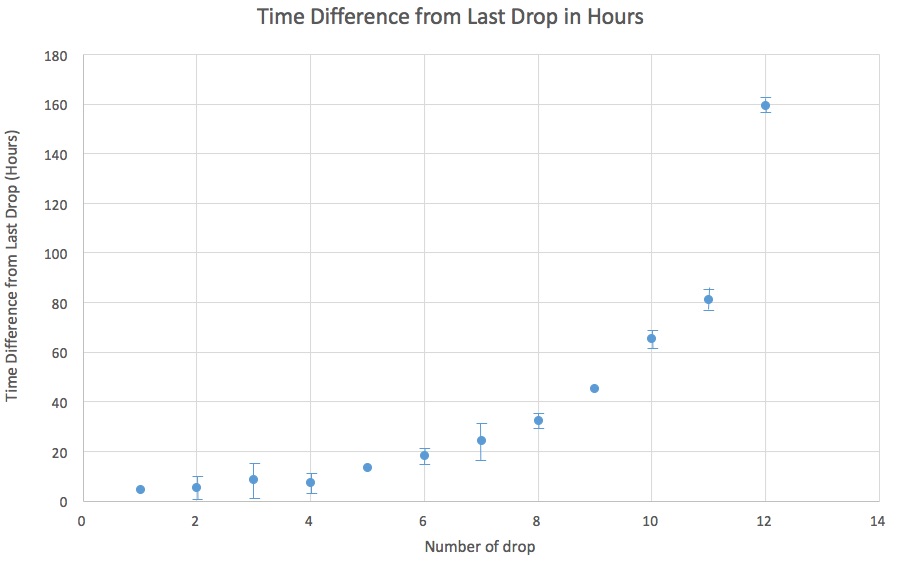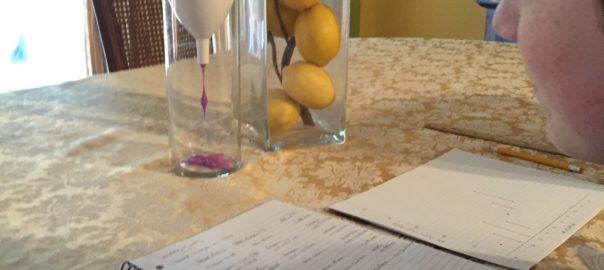The Pitch Drop Experiment housed at the University of Queensland in Australia is listed in the Guinness Book of World records as the world’s longest-running laboratory experiment.1 The experiment was started in 1927 when heated pitch, a viscous material derived from tar, was placed in a funnel and allowed to drip very slowly. It has been over a decade between the most recent drops falling.
For the science educator who wants to reproduce this classic experiment but does not have that kind of time to spare, an alternative would be to use silicone polymer, such as Silly Putty. To test this idea, I had 245 grams of temperature-sensitive color-changing putty on hand from Crazy Aaron’s Thinking Putty2 from another project and placed it in a funnel and left it to drip into a glass vase. The setup was kept at a relatively constant room temperature, around 70 degrees F. Twelve drops were recorded falling over a three-week period of time. Sometimes the drop was witnessed to fall and the time recorded to the nearest minute, but other times, there was a span of time that a drop could have fallen such as during the night or work hours.
Before the first drop fell.

After the 4th drop fell.


The time between each successive drop of the putty increased over time. After a few weeks, a dry skin formed on the putty as it was drying out which increased the viscosity and thus the time difference between drops. A small bubble formed at the surface of the putty after some of the drops.
This experiment could be done with students in which they could learn about the history of the original pitch drop experiment and then have collaboratively watch the system during the school day throughout a few weeks. Many discussions could be instigated about the tracking of data, uncertainty when you miss the drop, predictions about when they expect the drops to fall, or ideas about getting more accurate information such as setting up a web cam, time-lapse camera, or photo-gates connected to a computer to record the falling of the drops. An additional suggestion for further study would be to try different types of putty, such as Theraputty,3 color-coded occupational therapy hand exercise material with different resistances for people to recovering from injuries or arthritis.
References:
- http://smp.uq.edu.au/content/pitch-drop-experiment
- https://puttyworld.com
- https://www.fab-ent.com/brands/theraputty/
Data Table:
| Date and Time | Event | Total Time | Duration |
| Hours | Hours | ||
| 9/1/15 4:30 pm | Started | 0 | – |
| 9/1/15 9:23 pm | 1st drop fell | 4.88 | 4.88 |
| Between 11 pm on 9/1/15 and 7 am on 9/2/15 | 2nd drop fell | Between 6.50 and 14.5 | Between 1.62 and 9.62 |
| Between 8 am and 3:30 pm on 9/2/15 | 3rd drop fell | Between 15.5 and 23.0 | Between 1.00 and 16.5 |
| 9/2/15 7:20 pm | 4th drop fell | 26.8 | Between 3.83 and 11.33 |
| 9/3/15 8:45 am | 5th drop fell | 40.3 | 13.4 |
| Between 11:30 pm 9/3/15 and 6:30 am 9/4/15 | 6th drop fell | Between 55.0 and 62.0 | Between 14.8 and 21.8 |
| Between 11:30 pm 9/4/15 and 7 am 9/5/15 | 7th drop fell | Between 79.0 and 86.5 | Between 17.0 and 31.5 |
| 9/6/15 11:52 am | 8th drop fell | 115.4 | Between 28.9 and 36.4 |
| 9/8/15 9:15 am | 9th drop fell | 160.8 | 45.4 |
| Between 12:30 am and 6:30 am 9/11/15 | 10th drop fell | Between 223.5 and 229.5 | Between 62.8 and 68.8 |
| Between 11:30 am and 2:00 pm 9/15/15 | 11th drop fell | Between 306.5 and 309.0 | Between 77.0 and 85.5 |
| Between 11:30 pm 9/21/15 and 6:30 am 9/22/15 | 12th drop fell | Between 462.5 and 472 | Between 153.5 and 163 |
